Saint Montan
 Located
in Bas-Vivarais, between Fish ponds and Borough-Saint-Andéol, the
commune of Saint-Montan extends around his old medieval borough.
Located
in Bas-Vivarais, between Fish ponds and Borough-Saint-Andéol, the
commune of Saint-Montan extends around his old medieval borough.
Saint-Montan has as an originality to be the only commune of France to bear this name.
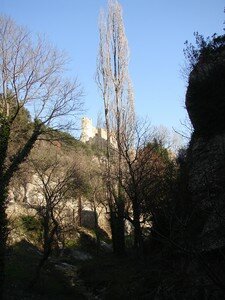
The
prehistorians recognize in Bas-Vivarais one of most populated the areas
southernmost France for the period of the Neolithic era. With the
origin, the habitat is in caves or shelters - under - rock, which
constituted a privileged refuge.
At the first century after J-C, an important locality exists in the North of Saint-Montan. With the Roman occupation and the Emperor Auguste, she experiences a considerable development and becomes Alba Augusta Helvirium, capital of Helvie. The Roman way of Narbonne in Lyon crosses Borough-St-Andéol, then moves towards North and Alba while passing through Saint-Montan.
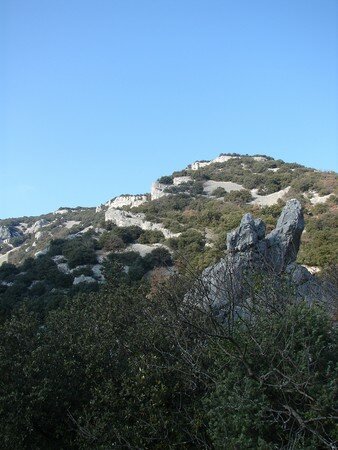 The
origin of the village of Saint-Montan goes back to the 5th century at
the time of the stay of a hermit of the name of Montanus, related at
the house of Lorraine and resulting from a princely family of
Austrasie. The legend reports to us that at the 5th century lived in
Laon piles character called Montanus. Its reputation of holiness was
large and it predicts with Célini lady that she would put at the world
a son and that he would have a great destiny. This wire was Saint Remi,
archevâque of Rheims, which baptized Clovis into 496. Montanus,
importuned by the multitude of the visitors whom his reputation of
holiness attracted, left Laon and sought in midday a loneliness where
it could request God in peace. The hot valley allured it by its
roughness and its proximity with Borough-Saint-Andéol. It would have
lived 30 years in the cave of the hot valley a life of loneliness. Then
it was discovered by the hunters and receipt the visit of Remi Saint
and Jean, bishop of Fish ponds, which requested it to settle in a more
accessible place (current place of the vault San Samonta). The
multitude of visitors obliged it to leave the country and it was
withdrawn in Fère, in Picardy, where it would have died and where his
relics would be preserved.
The
origin of the village of Saint-Montan goes back to the 5th century at
the time of the stay of a hermit of the name of Montanus, related at
the house of Lorraine and resulting from a princely family of
Austrasie. The legend reports to us that at the 5th century lived in
Laon piles character called Montanus. Its reputation of holiness was
large and it predicts with Célini lady that she would put at the world
a son and that he would have a great destiny. This wire was Saint Remi,
archevâque of Rheims, which baptized Clovis into 496. Montanus,
importuned by the multitude of the visitors whom his reputation of
holiness attracted, left Laon and sought in midday a loneliness where
it could request God in peace. The hot valley allured it by its
roughness and its proximity with Borough-Saint-Andéol. It would have
lived 30 years in the cave of the hot valley a life of loneliness. Then
it was discovered by the hunters and receipt the visit of Remi Saint
and Jean, bishop of Fish ponds, which requested it to settle in a more
accessible place (current place of the vault San Samonta). The
multitude of visitors obliged it to leave the country and it was
withdrawn in Fère, in Picardy, where it would have died and where his
relics would be preserved.
The name of the village thus comes from
this saint hermit, and is written correctly without T. “Per the san
Montan the oulivo with the man” becomes a saying of the country (with
the Montan Saint, one can gather olives…)
 The
hermitage became a priory thereafter. The seigniory of Balazuc settled
at the beginning of XIe century and built there a castle at side of
which was born a strengthened medieval village.
The
hermitage became a priory thereafter. The seigniory of Balazuc settled
at the beginning of XIe century and built there a castle at side of
which was born a strengthened medieval village.
The strong castle, built on the spur rock of Agache, will constitute
the starting point of the current borough. The central building seems
to be built with a strictly military aim in XIème century. Then with
the wire of the centuries, the castle increased with new constructions
having a residential vocation. Progressively with these extensions, the
ramparts were increased to ensure the protection of the houses. In the
current of XVème century, the borough castral will reach the banks of
the two brooks: its total surface is 2 hectares. It will be surrounded
then of an important traced enclosure very regularly, which exists in
major part still today.
With the XVI ème century the borough
becomes seigniory of the Greenhouses, with the XVII ème, Co-seigniory
with prevalence of the bishop of Fish ponds.
Church San Samonta
 It
is located at the exit of the village, in direction of Larnas, on the
site of the second residence of Montanus. It is in its honor that a
vault was built. The current building is composed of two distinct
parts: a vault of Xème century and a Romance church of XIIème century.
In XIIIe century, it is the parish church of Castrum.
It
is located at the exit of the village, in direction of Larnas, on the
site of the second residence of Montanus. It is in its honor that a
vault was built. The current building is composed of two distinct
parts: a vault of Xème century and a Romance church of XIIème century.
In XIIIe century, it is the parish church of Castrum.
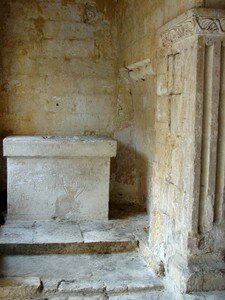 The
small vault underwent some small modifications (windows, carries of
entry) which do not denature initial construction. It is composed of an
arched rectangular room, followed to the East of a lengthened apse.
The
small vault underwent some small modifications (windows, carries of
entry) which do not denature initial construction. It is composed of an
arched rectangular room, followed to the East of a lengthened apse.
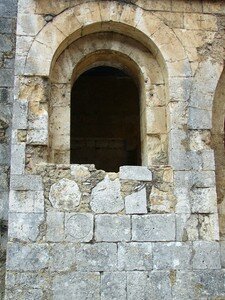 Between
this vault and the church is a rectangular room which was used as cell
for the monks. It communicates with the church by an arcade in
full-clotheshanger. The church is of a disconcerting architecture and
was altered on several occasions. It is established in an exiguous
place, against cliff, which explains a special design. It is a church
about the cistercians, from where a great sobriety, few decorations and
not bell-tower. The porch was added subsequently vraissemblablement at
the end of the XII ème century.
Between
this vault and the church is a rectangular room which was used as cell
for the monks. It communicates with the church by an arcade in
full-clotheshanger. The church is of a disconcerting architecture and
was altered on several occasions. It is established in an exiguous
place, against cliff, which explains a special design. It is a church
about the cistercians, from where a great sobriety, few decorations and
not bell-tower. The porch was added subsequently vraissemblablement at
the end of the XII ème century.
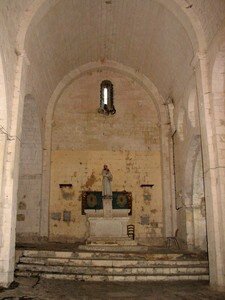 Outside,
one can notice many stones of re-employment, sundials, concise signs.
Western side one can see the site of a former priory. Inside, two
sealed inscriptions coming from the primitive church.
Outside,
one can notice many stones of re-employment, sundials, concise signs.
Western side one can see the site of a former priory. Inside, two
sealed inscriptions coming from the primitive church.
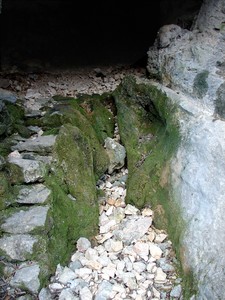 These
places very early seem to be attended because of the presence of
sources associated with the caves, the rocks and the very close forest.
These
places very early seem to be attended because of the presence of
sources associated with the caves, the rocks and the very close forest.
The
most important source, which never dries up normally (I do not know
what they did, but more water of the whole when I passed… on the other
hand, it is quite clean, the quite white stones… grrrrr) names “the
Fountain of the Fevers” (Montanus having communicated the virtue to him
to cure the fevers); it is seen sourdre under the road, with the height
of the small stopping. It remained a long time one of the principal
water points of the villagers, the way which connects it directly to
the castle in fact faith.
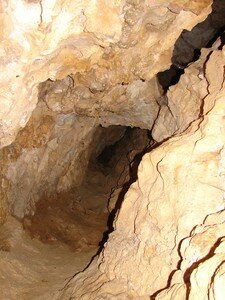 I
could thread me rather far in the cave, and aisi to see me that the
network acquifère is divided into several boyeaux, of which one which
goes up in direction of the church, and another which is inserted in
the depths of the ground.
I
could thread me rather far in the cave, and aisi to see me that the
network acquifère is divided into several boyeaux, of which one which
goes up in direction of the church, and another which is inserted in
the depths of the ground.
A small source appears now downstream. There remains, dug in cliff, the drain on the basis of the crowned source, empties now…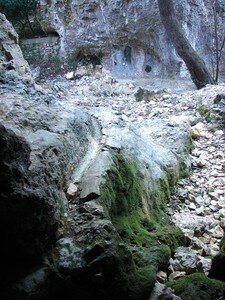
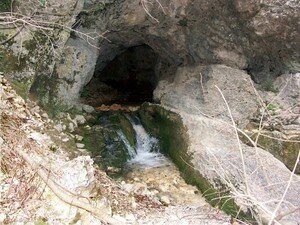 I found a photograph where one sees the source with his miraculous water…
I found a photograph where one sees the source with his miraculous water…
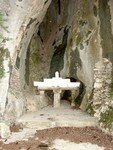 The
cave of Doors, built in an excavation of cliff opposite, was set up in
1905. Some miracles would have occurred there. The source was to still
run… This place at that time is currently interdict of access for
reasons of safety.
The
cave of Doors, built in an excavation of cliff opposite, was set up in
1905. Some miracles would have occurred there. The source was to still
run… This place at that time is currently interdict of access for
reasons of safety.
Saint Montain or Montan, hermit in Fère (5th century)
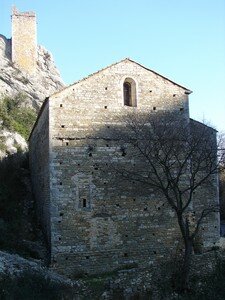 While
Gaules, at the 5th century, were the theatre of the wars, of
misappropriations and the plunders, a recluse, named Montain or Montan
(Montanus), lived on Expensive, close to Juvigny, in Luxembourg. Formed
with the virtue as of childhood, it lived separate world to have of
trade only with God and to be delivered entire to the exercises of
penitence. Worried in its retirement by the races of the Barbarians, it
left it and went to seek a major loneliness with Fère (Aisne), place
then filled with wood, surrounded chasms and marsh. There, Montan, all
occupied needs for the Church disturbed by the wars and the heresy of
Nestorius that the Ecumenical Council of Ephèse (431) had just
condemned, did not cease beseeching the help of the Sky. Its prayers
were not without effect. One day that Montan rested of a light sleep,
it by 3 times was informed to predict in Célinie, noble lady region,
that it would have a son, and of him to declare of them at the same
time the name and the merits. Suddenly it seems to him that, by a
divine grace, it is transported in the middle of the chorus of the
Angels and the assembly of the holy hearts, holding council unit and
conferring subversion or restoration as of the Churches of Gaules: all
declare that time had just had pity of it; and, at the same time, a
voice which resounds with softness makes hear of a higher place and
more secrecy: “The Lord looked of the Sky and Holy of Holies
While
Gaules, at the 5th century, were the theatre of the wars, of
misappropriations and the plunders, a recluse, named Montain or Montan
(Montanus), lived on Expensive, close to Juvigny, in Luxembourg. Formed
with the virtue as of childhood, it lived separate world to have of
trade only with God and to be delivered entire to the exercises of
penitence. Worried in its retirement by the races of the Barbarians, it
left it and went to seek a major loneliness with Fère (Aisne), place
then filled with wood, surrounded chasms and marsh. There, Montan, all
occupied needs for the Church disturbed by the wars and the heresy of
Nestorius that the Ecumenical Council of Ephèse (431) had just
condemned, did not cease beseeching the help of the Sky. Its prayers
were not without effect. One day that Montan rested of a light sleep,
it by 3 times was informed to predict in Célinie, noble lady region,
that it would have a son, and of him to declare of them at the same
time the name and the merits. Suddenly it seems to him that, by a
divine grace, it is transported in the middle of the chorus of the
Angels and the assembly of the holy hearts, holding council unit and
conferring subversion or restoration as of the Churches of Gaules: all
declare that time had just had pity of it; and, at the same time, a
voice which resounds with softness makes hear of a higher place and
more secrecy: “The Lord looked of the Sky and Holy of Holies ,
in the ground, to hear the moanings of those which are enchainés, and
to break irons of wire of those which perished, so that Its Name is
announced among the nations, and that the people and the kings meet
together to serve It”. - The voice said “that Célinie would design a
son, named Remi, to which the people would be entrusted to be saved”.
,
in the ground, to hear the moanings of those which are enchainés, and
to break irons of wire of those which perished, so that Its Name is
announced among the nations, and that the people and the kings meet
together to serve It”. - The voice said “that Célinie would design a
son, named Remi, to which the people would be entrusted to be saved”.
After
having received so great and so soft consolation, the saint character,
3 times informed to achieve its mission, came to announce in Célinie
the oracle of the celestial vision. However, this happy mother had had
a long time before, in the flower of her youth, sound alone and single
husband Emile, a son named Principe (or Prince), since bishop of
Soissons, and father of saint Loup, her successor with the episcopate
of the same city: happy Célinie is astonished; she cannot
include/understand how, already old woman, she will give birth to her
son and will nourish it of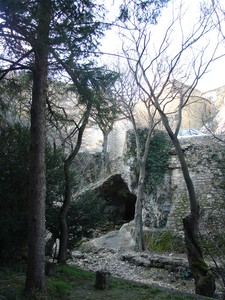 its
milk, the more so as her husband and itself, largely advanced in age,
exhausted, had any more neither hope nor desire to have from now on
children. But happy Montan, become blind for a time, so that the merits
of patience abounded in him, declares in Céline that its eyes must be
sprinkled with its milk and that at once it will recover the sight.
However the happy parents deliver themselves to the joy of a so great
consolation, and, “when the moment arrived”, the future potife of
Jesus-Christ comes in the world fortunately and receives, on the saints
font of Baptism, the name of Remi. The happy promise made to the
Prophète saint is thus accurately accomplished: because, during breast
feeding, its eyes are sprinkled milk of the happy Célinie mother, and
it covers the sight miraculeusement. - Dom Lelong says “that it is in
Cerny, where was the castle of Celine, which the preceding scene would
have occurred”. - If Montan still lived a few years after having
recovered the sight, it turned over in its loneliness of Fère, to the
bond says the Pit of Saint-Montan; it died there on May 17. The city of
Fère and its collegial took for holy owner Montan. One preserves, still
today, a small portion of his relics to the parish church and the vault
of the Hospital; they were recognized authentic by the Roman bishop of
Beaulieu, mgr Leblanc. The festival of the Saint is celebrated with
Fère with a great solemnity on May 17; and, during the 9 following
days, the faithful ones continue to come to venerate its relics. - The
catbédrale of Laon formerly had the chief and an arm of the solitary
saint; the abbey of Juvigny had the principal part of its body.
its
milk, the more so as her husband and itself, largely advanced in age,
exhausted, had any more neither hope nor desire to have from now on
children. But happy Montan, become blind for a time, so that the merits
of patience abounded in him, declares in Céline that its eyes must be
sprinkled with its milk and that at once it will recover the sight.
However the happy parents deliver themselves to the joy of a so great
consolation, and, “when the moment arrived”, the future potife of
Jesus-Christ comes in the world fortunately and receives, on the saints
font of Baptism, the name of Remi. The happy promise made to the
Prophète saint is thus accurately accomplished: because, during breast
feeding, its eyes are sprinkled milk of the happy Célinie mother, and
it covers the sight miraculeusement. - Dom Lelong says “that it is in
Cerny, where was the castle of Celine, which the preceding scene would
have occurred”. - If Montan still lived a few years after having
recovered the sight, it turned over in its loneliness of Fère, to the
bond says the Pit of Saint-Montan; it died there on May 17. The city of
Fère and its collegial took for holy owner Montan. One preserves, still
today, a small portion of his relics to the parish church and the vault
of the Hospital; they were recognized authentic by the Roman bishop of
Beaulieu, mgr Leblanc. The festival of the Saint is celebrated with
Fère with a great solemnity on May 17; and, during the 9 following
days, the faithful ones continue to come to venerate its relics. - The
catbédrale of Laon formerly had the chief and an arm of the solitary
saint; the abbey of Juvigny had the principal part of its body.
http://home.scarlet.be/amdg/sankt/mai17.html
http://www.mairie-st-montan.fr/pages/decouverte.htm#02
http://www.fetes-du-rhone.com/st_montan.htm

/https%3A%2F%2Fprofilepics.canalblog.com%2Fprofilepics%2F1%2F1%2F116167.jpg)
/https%3A%2F%2Fstorage.canalblog.com%2F49%2F16%2F312499%2F14620054_o.jpg)
/https%3A%2F%2Fstorage.canalblog.com%2F53%2F18%2F312499%2F14151229_o.jpg)
/https%3A%2F%2Fstorage.canalblog.com%2F07%2F05%2F312499%2F14149867_o.jpg)
/https%3A%2F%2Fstorage.canalblog.com%2F11%2F35%2F312499%2F14149307_o.jpg)
/https%3A%2F%2Fstorage.canalblog.com%2F90%2F14%2F312499%2F14125247_o.jpg)
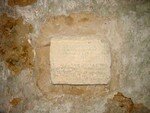


/https%3A%2F%2Fstorage.canalblog.com%2F12%2F98%2F137895%2F6624411_p.jpg)
/https%3A%2F%2Fstorage.canalblog.com%2F34%2F82%2F137895%2F27207854_p.jpg)
/https%3A%2F%2Fstorage.canalblog.com%2F32%2F37%2F137895%2F15872299_p.jpg)
/https%3A%2F%2Fstorage.canalblog.com%2F37%2F81%2F137895%2F15879822_p.jpg)